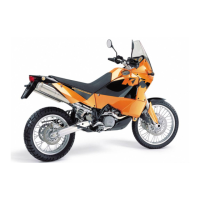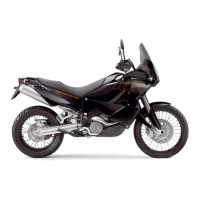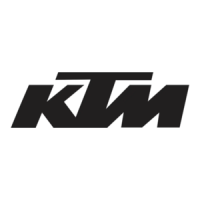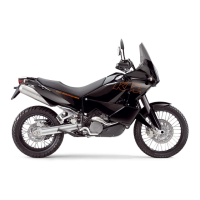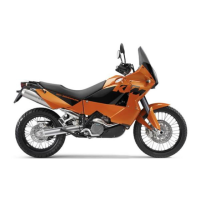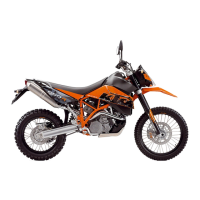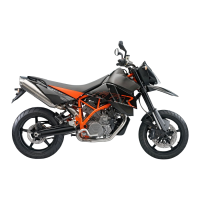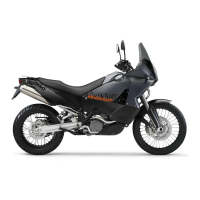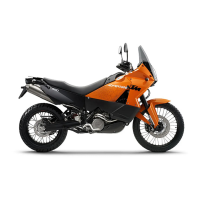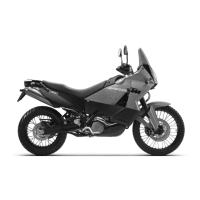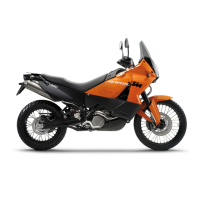How to make KTM Security System more sensitive?
- Sstephen25Sep 23, 2025
If the KTM Security System is too insensitive, the sensitivity level might be set too low. Increase the sensitivity level to resolve this.
How to make KTM Security System more sensitive?
If the KTM Security System is too insensitive, the sensitivity level might be set too low. Increase the sensitivity level to resolve this.
Why does my KTM 950 ADVENTURE Motorcycle engine crank but not start?
If your KTM Motorcycle engine cranks but doesn't start, it could be due to an operating error, a blown fuel pump fuse, or an oxidized plug and socket connector on the wiring harness. Ensure the fuel taps are open, there is fuel in the tank, and you've followed the correct starting procedure. Replace the fuel pump fuse. Clean the plug and socket connector on the wiring harness and spray with contact spray.
What to do if my KTM 950 ADVENTURE engine stalls while driving?
If your KTM Motorcycle engine stalls while driving, check for the following potential issues. First, ensure that you have enough fuel and that the fuel taps are open. Also, inspect the fuses: replace the fuel pump fuse if it has blown and replace the ACC2 fuse. The carburetor may be icing.
Why won't my KTM 950 ADVENTURE Motorcycle engine reach full power?
If your KTM Motorcycle engine won't reach full power, it could be due to a partially interrupted fuel supply, leaking carburetors, a very dirty air filter or the wrong ignition curve being activated. Check the fuel taps and fuel lines for any kinks. Inspect the vacuum and venting hoses of the carburetors for correct positioning. If you are using fuel with at least RON 95 (USA = Premium RON 91), activate the ignition curve for 95 octane.
What to do if my KTM Motorcycle engine overheats?
If your KTM Motorcycle engine overheats, first check the cooling liquid level and refill if necessary, also inspect the cooling system for leaks. Ensure the radiator fins are clean. If foam is forming in the cooling system, replace the cooling liquid with a brand-name antifreeze. Also, check if the radiator hose is kinked or damaged. Replace the fuse FAN if it has blown.
What to do if KTM Security System siren sounds unusual or faint?
If the KTM Security System siren sounds unusual or too faint, even when uncovered, the internal siren may be damaged or there may be water in the sound projector. Send the system in for repair, or install the system in a way that allows water to drain from the sound projector.
What causes the KTM Security System immobilizer to activate while the engine is on?
If the KTM Security System immobilizer activates while the engine is running, there may be a cable rupture or loose contact. Inspect the cable for continuity under tensile load, replacing it if necessary. Also, check all electrical connections to ensure they are secure.
Why does KTM Security System self-arm when the ignition is on?
If your KTM Security System self-arms while the ignition is on, the blue cable might not be receiving 12V. Measure the voltage on the blue cable with the ignition on and, if necessary, select a different terminal.
Why does my KTM Security System have occasional false alarms?
If your KTM Security System triggers occasional false alarms, it might be due to a high sensitivity level, engine noises during cooling, or loose connections in the contact loop. Try selecting a lower sensitivity level, choosing a different installation spot, and inspecting the contact loop connectors.
What to do if my KTM Motorcycle engine only cranks with the clutch lever pulled?
If your KTM Motorcycle engine only cranks when the clutch lever is pulled, it's likely because a gear is engaged. Shift the transmission to neutral.
Overview of the digital speedometer, its display modes, and indicator lamps.
Explanation of the cooling liquid temperature display and its warning indications.
Explanation of the function of different indicator lamps on the dashboard.
Details on the ignition lock's positions for starting, running, and securing the motorcycle.
Operation of the combination switch for high/low beam, turn signals, and horn.
Function of the emergency OFF, light, and starter switches for safe operation.
Steps for initial operation, including checks and familiarization with controls.
Guidelines for the break-in period of the LC8 engine to ensure proper performance.
Safety warnings and advice on carrying accessories and payload affecting handling.
Mandatory checks before each start, including fuel, tires, brakes, and cables.
Steps for starting the engine when it is cold, including choke and starter operation.
Steps for starting the engine when it is warm or hot, focusing on smooth ignition.
Procedure for starting off from a standstill, engaging gear and releasing clutch.
Techniques for shifting gears and riding the motorcycle smoothly and safely.
Proper techniques for applying brakes, including handling different surfaces.
Steps for stopping the engine and parking the motorcycle securely and safely.
Details on recommended fuel types, octane ratings, and refueling safety precautions.
Essential checks and care procedures for the owner or mechanic to perform regularly.
Procedure for adjusting the fork's compression damping to match riding style.
Procedure for adjusting the fork's rebound damping for ride comfort and handling.
Method for adjusting the fork spring preload to suit rider weight and load.
Adjusting the shock absorber's compression damping for different riding conditions.
Adjusting the shock absorber's rebound damping for optimal ride characteristics.
Adjusting the shock absorber's preload using the hand wheel for load adaptation.
Information on brake calipers, pads, fluid reservoirs, fluid type, and brake discs.
Checking tire pressure, condition, and using approved tires for safety and performance.
Recommended engine oil types and procedures for checking the oil level.
Detailed procedure for changing engine oil, oil filter, and cleaning the oil screen.
Troubleshooting common issues when the engine does not start or cranks slowly.
Troubleshooting issues like engine stalling, loss of power, or overheating.
Resolving issues like engine stalling, high oil consumption, and lighting failures.
Diagnosing and fixing issues with the battery, display, and lighting systems.
Table of basic settings for fork and shock absorber compression, rebound, and preload.
Torque specifications for various chassis bolts, including engine and frame components.
Overview of the digital speedometer, its display modes, and indicator lamps.
Explanation of the cooling liquid temperature display and its warning indications.
Explanation of the function of different indicator lamps on the dashboard.
Details on the ignition lock's positions for starting, running, and securing the motorcycle.
Operation of the combination switch for high/low beam, turn signals, and horn.
Function of the emergency OFF, light, and starter switches for safe operation.
Steps for initial operation, including checks and familiarization with controls.
Guidelines for the break-in period of the LC8 engine to ensure proper performance.
Safety warnings and advice on carrying accessories and payload affecting handling.
Mandatory checks before each start, including fuel, tires, brakes, and cables.
Steps for starting the engine when it is cold, including choke and starter operation.
Steps for starting the engine when it is warm or hot, focusing on smooth ignition.
Procedure for starting off from a standstill, engaging gear and releasing clutch.
Techniques for shifting gears and riding the motorcycle smoothly and safely.
Proper techniques for applying brakes, including handling different surfaces.
Steps for stopping the engine and parking the motorcycle securely and safely.
Details on recommended fuel types, octane ratings, and refueling safety precautions.
Essential checks and care procedures for the owner or mechanic to perform regularly.
Procedure for adjusting the fork's compression damping to match riding style.
Procedure for adjusting the fork's rebound damping for ride comfort and handling.
Method for adjusting the fork spring preload to suit rider weight and load.
Adjusting the shock absorber's compression damping for different riding conditions.
Adjusting the shock absorber's rebound damping for optimal ride characteristics.
Adjusting the shock absorber's preload using the hand wheel for load adaptation.
Information on brake calipers, pads, fluid reservoirs, fluid type, and brake discs.
Checking tire pressure, condition, and using approved tires for safety and performance.
Recommended engine oil types and procedures for checking the oil level.
Detailed procedure for changing engine oil, oil filter, and cleaning the oil screen.
Troubleshooting common issues when the engine does not start or cranks slowly.
Troubleshooting issues like engine stalling, loss of power, or overheating.
Resolving issues like engine stalling, high oil consumption, and lighting failures.
Diagnosing and fixing issues with the battery, display, and lighting systems.
Table of basic settings for fork and shock absorber compression, rebound, and preload.
Torque specifications for various chassis bolts, including engine and frame components.
| Engine Type | V-twin, 4-stroke |
|---|---|
| Displacement | 942 cc |
| Cooling System | Liquid cooled |
| Transmission | 6-speed |
| Front Suspension | WP USD 48 mm |
| Bore x Stroke | 100 mm x 60 mm |
| Fuel System | Carburetor |
| Rear Suspension | WP monoshock |
| Front Brakes | Dual 300 mm discs, 2-piston calipers |
| Rear Brakes | 240 mm Brembo disc with 2-piston caliper |
| Fuel Capacity | 22 liters |
| Power | 98 hp |
| Torque | 95 Nm |
| Wheelbase | 1570 mm |
